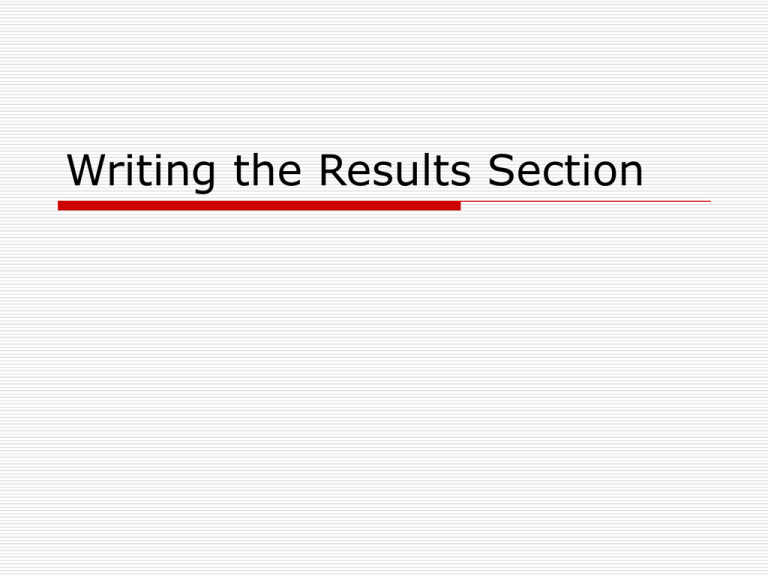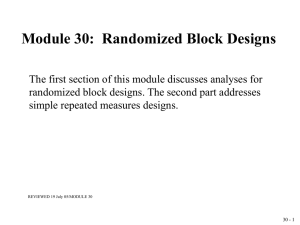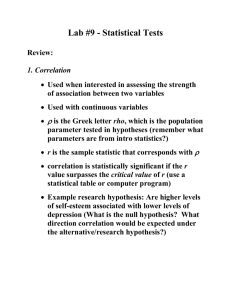WritingtheResultsSec..
advertisement

Writing the Results Section Some Studies with Results Sections Reporting Common Statistical Tests and Procedures Study which reports the results of chisquare tests of hypotheses Study which reports the results of factor analysis, logistic regression, and multiple regression analysis Study which reports the results of ANOVA tests of main and interaction effects in an experiment Study which reports the results of ANOVA tests in a non-experimental design Sample Results reporting from Some of our Previous Analyses, Labs, and Exam Reporting an ANOVA result for a one-way ANOVA To test the hypothesis that marital status has a significant impact on hours spent watching TV, a one-way analysis of variance was conducted. A significant value of F (4, 1483) of 10.684 was obtained (p<.001). The effect size (partial eta squared) was .028. Power to detect the effect was .999. The Levene test for the equality of variances among the levels of the independent variable (marital status) found that the variances were significantly different (F = 4.622, p < .01), suggesting that an alternative post hoc test for pairwise differences of means should be used. The mean TV hours watched by marital status were: widowed, 3.91; separated, 3.00; divorced, 2.96, never married, 2.91; and married, 2.67. Post-hoc tests of pair-wise mean differences using the Tamhane T2 statistic indicated that significant differences in hours spent watching television were obtained between married and widowed, between widowed and divorced, and between widowed and never married. Although the significant overall F and significant post hoc differences indicated that there was a tendency for marital status to influence number of hours spent watching TV, the effect size was very small even given statistical power of .99. Sample Results reporting from Some of our Previous Analyses, Labs, and Exam, cont’d Reporting the results of a t-test: The hypothesis was tested that people who own their own home watch significantly fewer hours of TV per day than people who do not own their own home (t (unequal variances) = -3.914, df = 529.171, p <.005). People who owned their own home watched an average of 2.70 hours of TV per day, while people who did not own their own home watched an average of 3.37 hours of TV per day. Writing up a Multiple Regression Reporting the results of a hierarchical multiple regression analysis To test the hypothesis that a country’s level of male literacy is a function of three variables, the country’s annual increase in population, percentage of people living in cities, and gross domestic product, a hierarchichal multiple regression analysis was performed. Tests for multicollinearity indicated that a very low level of multicollinearity was present (VIF = 1.54 for people living in cities, 1.15 for annual increase in population, and 1.663 for gross domestic product). People living in cities was the first variable entered, followed by annual population increase and then GDP, according to our theory. Results of the regression analysis provided partial confirmation for the research hypothesis. Beta coefficients for the three predictors were people living in cities, β = .493, t = 5.539, p < .001; annual population increase, β = -.517, t = -6.698, p < .001; and gross domestic product, β = -.063, t = -.676, p = .501, n.s. The best fitting model for predicting rate of male literacy is a linear combination of the country’s annual population increase and the percentage of people living in cities (R = .762, R2 = .581, F (2,82) = 56.823, p < .001). Addition of the GDS variable did not significantly improve prediction (R2 change = .002. F = .457, p = .501). Where to Look for Guidance in the APA Manual For the best guidance on writing the results section, consult the APA style manual, pp. 20-27, and the section on tables and figures, pp. 147-204, which includes many examples for different types of analyses On pages 140-144 there are tables about how to refer to statistical symbols and abbreviations in the text Generally speaking, when preparing your paper for publication you italicize these: N, M, df, p, SS, SE t, F, a, and b, R, R2, H when referring to a hypothesis And you leave these in regular type: MANOVA, ANOVA, β, µ, or other Greek symbols, and superscripts and subscripts that don’t refer to variables such as when you’re squaring or indicating that X is the first variable, second variable, etc General APA Guidelines on Writing the Results Section Your main priority in the Results section is to report on the tests of your hypothesis and tell your reader whether or not you obtained evidence in support of your research hypotheses, or failed to do so Tie your writing closely to the hypotheses. Restate the hypothesis under discussion near the beginning of the paragraph and identify the type of test used to assess it. Discuss all the hypotheses in the order in which you presented them If there is a great deal of material, for example multiple dependent variables for which you want to report means, use a table instead of text. Text is for the statistic used to test the hypothesis, the df, the p level, power, effect size, etc or for a report of means if there are only a few variables Don’t report raw scores even in a table, although you may refer the reader to where they can find it if they are interested and there are no human subjects issues involved in making it available More Guidelines from APA Generally tables are preferred to figures, and no figures are preferred to figures that are home-made looking or not camera ready Most publishers are not interested in reproducing photographs and will complain about it unless they are required for understanding (for example, they constitute the levels of one of the factors in an ANOVA design) Be sure to refer to all tables and figures in the text; don’t just stick them in without warning The usual convention is to leave space for a table and fill that space with a note to the publisher that says [Table 1 about here] in the spot where you want it to go. Then you put the tables in order at the end of the document after the references and appendices Whenever possible include the items used in your surveys or questionnaires in an appendix which you mention in the text of the Results section More Guidelines from APA What to report: One of the first things you report is the reliability of any measures you have used. Report alpha reliability or repeated measures correlations. If your alpha falls below .80 for any measure you should rethink using it Generally you should report the test statistic, the df, the probability level, the power, the effect size, the means if there are not too many, whether or not the hypothesis was supported, the direction of any effects or mean differences. Ns, means and standard deviations can be reported in a table. Some journals encourage reporting of confidence intervals And More APA Guidelines In a factorial design where there are multiple cells, also report the cell means, sample sizes for the cell, and cell standard deviations For an F test, reproduce the ANOVA table in a separate table (showing the SS for between and within, the mean squares, F, etc. This would include not only experiments or factorial designs but also other kinds of statistics whose significance is tested by F such as R2 Some journals require you to provide the variancecovariance or correlation matrix when you report on a multiple regression or correlation analysis. You can get this output easily from SPSS if needed Consult the APA manual for further details on specific analyses Consult the Results section of papers from your list of references and see what they reported What Doesn’t Go in the Results Section Remember that the Results section is not the place to speculate about why you got the results you did (you will do that in the Discussion), nor is it the place to say why you studied what you did (you should have done that in the Literature Review/Rationale) or to say how you did things (you should have done that in the Method section) Just tell the reader what you found Try to avoid saying things like, “even though the results were not significant, men did X more than women”. If it wasn’t a significant result, best to not report or interpret it (although some papers are full of results that “just missed significance”)











